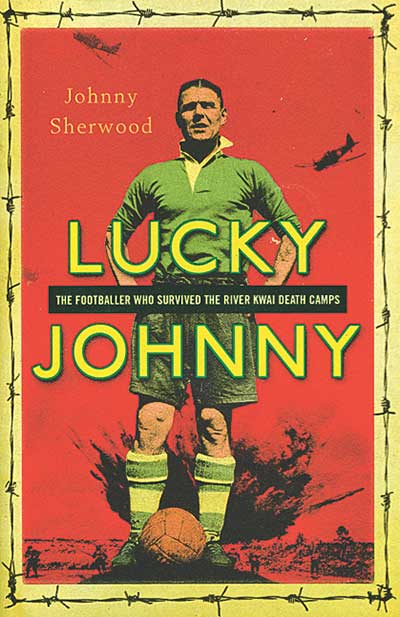 Lucky Johnny
Lucky Johnny
The footballer who survived the River
Kwai death camps
by Johnny Sherwood
Hodder & Stoughton, £20
The Happy Warrior
From Leeds United
to Burma
by Jan Rippin
Tricorn Books £9.50
Buy this book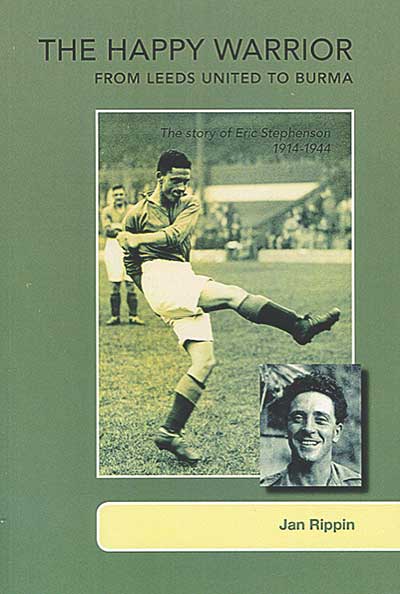
Reviewed by Roger Titford
From WSC 333 November 2014
There is a recent surge of interest in British footballers at war which may have deep and complex roots. These two titles appear coincidentally at the same time about two men whose war and lives bore remarkable similarities. Only one survived to tell his tale.
Johnny Sherwood (Lucky Johnny) was an embryonic professional at Reading, came home to a curtailed career and wrote a memoir, partly for therapeutic reasons, in later life. The manuscript was discovered last year by his grandson. Eric Stephenson (The Happy Warrior) was an established First Division player at Leeds United with two caps and was a member of the last England touring party before the war. His daughter Jan Rippin was just three when she last saw him and his death left an immense void in family life. Her loving tribute also acts as a means of easing pain.
A modern football audience needs to be alert to the difference between war books about men who happened to be footballers, rather than milkmen or lathe operators, and books about footballers who fought. These titles tread that line rather awkwardly at times because they are constructed more from the war perspective and their football content is a little sketchy.
Rippin’s account of her father is plainly written but nonetheless emotional, particularly in the latter half which deals with his war and death. She creates a picture of the kind of man we no longer seem to have: working class, inspired by books, chapel and political discussion and now memorialised in stained glass. Every last drop of available personal detail is squeezed out of the Leeds match reports but little else is conveyed about his life as a footballer. He was posted to Burma in 1942, rose to the rank of major and fought there until his death in action in September 1944.
In the very same week Sherwood came closest to death, being torpedoed and afloat in the South China Sea for 17 hours. Having been captured just days after landing in Singapore in 1942 he spent most of the next two years working as slave labour for the Japanese building the “railway of death” by the River Kwai. His fitness and status as a footballer enabled him to survive several dangerous moments and his memoir is utterly harrowing, with comrades dying horribly on every other page.
There are some footballing nuggets here and there, notably actually playing matches against the guards who treated them so badly and cautiously not winning too well. This example of football as a bridge between men, more remarkable than the Christmas Day truce match of 1914, would benefit, as would other incidents, from being highlighted in an accompanying commentary. Sherwood survived to briefly pick up his League career with Aldershot but the trauma from having played his part in what literary folk called “the greater game” stayed with him until his death in 1985.
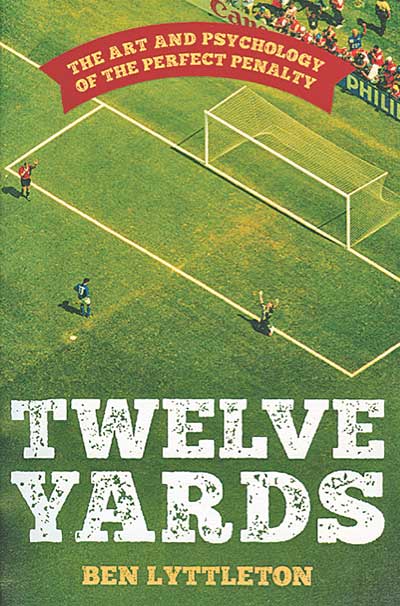 The art & psychology of the perfect penalty
The art & psychology of the perfect penalty
by Ben Lyttleton
Bantam Press, £14.99
Reviewed by Jonathan O’Brien
From WSC 333 November 2014
The glib explanation for the English fascination with penalties is because they lose so many shootouts and are thus mesmerised by the idea of actually being good at them, somewhat like a gormless youth trying to work out the secret of successfully conversing with an attractive woman. Of course, just as a confident man is likely to have more success in a nightclub than a self-conscious one, if they (by which I mean England players) spent less time thinking about penalties, they’d probably fare a little better at them.
Ben Lyttleton explores this theme at length in Twelve Yards, a book which covers much the same ground as Andrew Anthony’s 2000 effort On Penalties (though it’s roughly twice as long). His conversation with Ricardo Pereira, the former Portugal goalkeeper whose penalty saves knocked England out of two different tournaments, soon becomes a faintly farcical catalogue of neurosis, jittery body language and general mental collapse.
Ricardo – who memorably took off the gloves to save Darius Vassell’s effort at Euro 2004 and then blasted in the winner himself – describes Vassell as “very nervous” in the run-up, notes that Steven Gerrard couldn’t look him in the eye and claims that Jamie Carragher’s “mind was fucked up” when the defender took what transpired to be his team’s final penalty in Gelsenkirchen in 2006. He finishes by giving three simple tips to England penalty-takers: focus on the positive, don’t think about the media and forget about the history. One of these might be easier to execute than the other two.
Lyttleton’s scope is nothing if not wide. He travels to South America to interview two penalty-taking keepers, José Luis Chilavert and Rogério Ceni, who ended their careers with well over 100 goals between them. “I was always calm,” Chilavert tells him with no discernible sarcasm. “I was playing a role on the pitch… Look, I could hardly be the hero with this face!”
He meets up with Antonin Panenka, scorer of the most famous penalty ever, outside a village pub near Prague, and discovers that while the legendary midfielder is justifiably proud of the clever little chip which won Euro 76, he also feels it has overshadowed everything else in his long career. Panenka theorises that the main reason for his worldwide fame is because his name “sounds the same in any language”.
But at times, you can sense Lyttleton straining to reach the word count (the book may have had more impact at a shorter length). One entire chapter is a retelling of the France v West Germany match in Seville in 1982, translated directly from a feature in France Football – it’s a very good read, admittedly, but relatively little of it has anything to do with penalties. There’s also a small handful of very bad mistakes – to pick one at random, Spain’s legendary keeper in the 1930s was named Ricardo Zamora, not Schavio Zamora. But this is a readable study of an almost unknowable art, as long as you don’t mind stumbling over yet another graph or table of stats every ten pages or so.
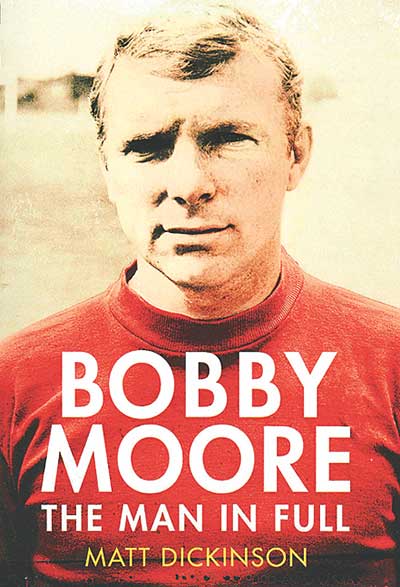 by Matt Dickinson
by Matt Dickinson
Yellow Jersey, £20
Reviewed by Mark Segal
From WSC 333 November 2014
When a modern-day footballer steps out of line, you don’t need to go far to find a sports writer of a certain vintage bemoaning today’s young millionaires and stating with utter certainty that this would not have happened in “Bobby’s day”.
The Bobby in question is of course late England captain Bobby Moore, whose legend and legacy has ascended to a higher place in the years following his untimely death from cancer in 1993 aged just 51.
According to legend, not only was Moore gifted with fantastic footballing skills but he was also a model professional who knew and understood the responsibilities of being captain of your country. It’s these assumptions about Moore which author Matt Dickinson sets out to investigate in this new book. And it’s a task he completes in some style.
Employing a straight chronological format, Dickinson guides the reader through Moore’s formative years as the shy youngster from Barking breaks into the West Ham first team. The book then centres on the middle years of the 1960s when Moore becomes a triple Wembley winner, first with West Ham in the FA Cup and Cup-Winners Cup and then finally with England in the World Cup final, before detailing his slow decline.
While Moore’s exploits on the pitch have been widely documented – except maybe for a bizarre nine-game stint for a small Danish team in 1978 – the strength of the book lies in the way Dickinson has been able to go beyond football and find Moore’s real character.
While Moore would often be the one instigating nights out with team-mates he was always more comfortable in the role as an observer rather than a performer. Former colleagues and friends alike describe a man who you thought you knew but actually didn’t. His private nature almost acted as a shield against whatever the world might throw at him. This detached nature is perfectly described in the beautifully written chapter about his death, as his second wife Stephanie speaks of the horror on his face as she broke down in tears after being told the disease had spread and there was no cure. Bobby never liked to make a scene.
While all the usual characters from his playing days turn up in the book, Dickinson also uses interviews with some of the journalists who followed Moore’s career at a time when players treated journalists as friends who they could confide in. He also speaks to both of Moore’s wives and also friends from outside football which all helps to provide a more rounded description of a difficult man to categorise.
The way he was ignored by football after his retirement is also discussed with the author believing a mixture of class snobbery, Moore’s lack of self-promotion and links with some of the East End’s more notorious characters all contributed to a managerial career which amounted to short spells at Oxford City and Southend.
Sadly, friends describe how as he entered his 50s Moore was finally beginning to come out of his shell and open up a bit more. Unfortunately, this new and relaxed Bobby was not given a chance to flourish. The passages about his final days make for difficult reading.
As a West Ham fan growing up just a few miles from where Bobby Moore was born, I was always going to have an interest in this book. Dickinson’s achievement has been to honour the memory of Moore while also allowing us to understand that he was far from perfect.
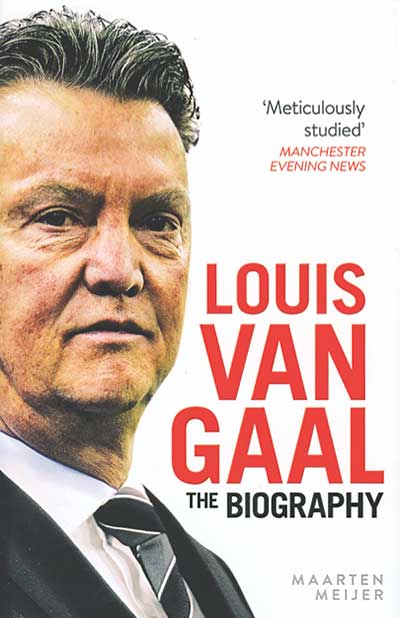 by Maarten Meijer
by Maarten Meijer
Ebury Press, £14.99
Reviewed by Joyce Woolridge
From WSC 333 November 2014
“When you traced the roots of the successful teams at the 2010 World Cup, every clue pointed back to one man: Louis van Gaal.” Maarten Meijer’s carefully researched biography is not afraid to make big claims for its subject. While conceding that credit is also due to Joachim Löw, Bert van Marwijk and Vicente del Bosque, Meijer argues that the controversial coach’s influence, through his work at Bayern Munich, Ajax and Barcelona, principally shaped the personnel, playing style and tactics of three of the four semi-finalists in South Africa. The book was finished before Holland’s unexpectedly barnstorming campaign in Brazil this summer and Germany’s victory (albeit also the Spanish collapse), which might serve as additional support for Meijer’s thesis on the extent of Van Gaal’s impact on European football.
It remains to be seen whether Van Gaal’s tenure at Old Trafford will provide further proof of the genius of “one of football’s most gifted architects”. The brief coda which deals with his United appointment, while stating the obvious that the £200 million “war chest” supposedly on offer “may have been an additional attraction” for Van Gaal, goes on to make the equally obvious observation that “he needs a new defence and a new midfield”. The final paragraph speculates that United will be his last management job and “he will want to go out with a bang, knowing that this is how he will be remembered not only in Manchester but in the entire world of football”, but reserves judgment on what sort of explosion Van Gaal will cause.
Meijer’s primary purpose in writing this heavyweight, thoughtful study, following his two previous biographies of Dick Advocaat and Guus Hiddink, is to balance the media caricature of Van Gaal, the crude stereotype of a lumbering, bombastic, dictatorial ex-PE teacher, ranting at the press and indulging in eccentric and bizarre behaviour (trouser-dropping, self-penned, excruciating poetry-reading) occasionally deemed akin to madness. Like Alex Ferguson, Meijer argues, Van Gaal is a man so out of style that he has become a “poster boy for the old-school, omnipotent, teacher-knows-best style of management”. So often following the boots of Johan Cruyff, as both player and coach, he has been cast as the anti-Cruyff, whereas his work should often be seen as complementary, Pep Guardiola’s all-conquering Barcelona being an amalgam of the philosophy of both coaches. In consequence there has been serious underestimation, if not misrepresentation, of Van Gaal’s talents and achievements. The real Van Gaal is more flexible and democratic in management and tactics, more humane and caring one-to-one.
Not that Meijer’s generally sympathetic account whitewashes over Van Gaal’s failings, or the barrage of criticism he has received, dealing with both at length. The most entertaining chapter predictably concerns Van Gaal’s fractious relations with the press. As boss of Ajax, he received a deliciously pompous letter from the Dutch Reporters’ Association, complaining press conferences were being “disgraced by vulgar shouting matches. This aggressive approach perhaps guarantees success with young, docile players but it is inappropriate at a press conference at which adult people are present”. At the next conference, in classic teacher mode, he asked those who signed it to put up their hands. Not one “adult” person did.
As a compatriot, Meijer could perhaps be forgiven his own excursions into national stereotypes. Van Gaal, he says, must be fundamentally understood as a typical Amsterdamer and Dutchman – hardnosed, unshakeably convinced he is right, highly focused, pig-headed, difficult to get along with and rebellious. Or as one journalist put it more succinctly: “An asshole, but certainly a competent asshole.”